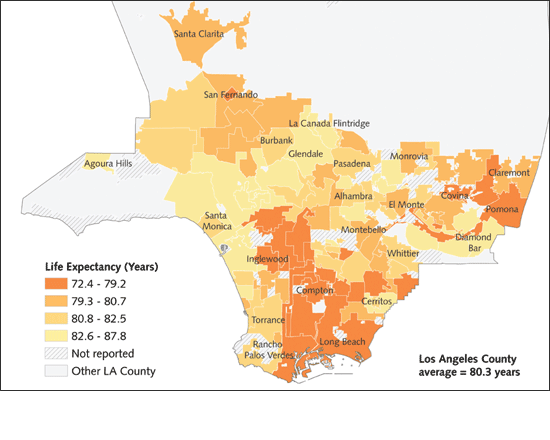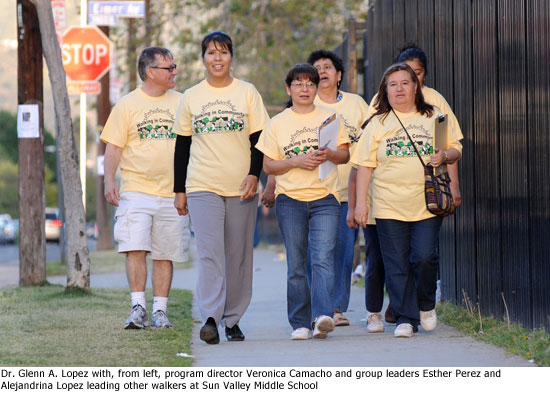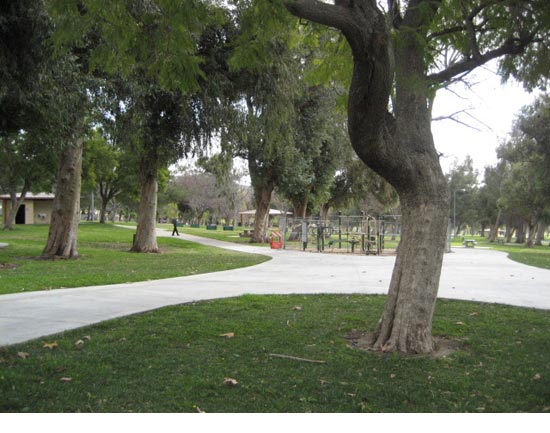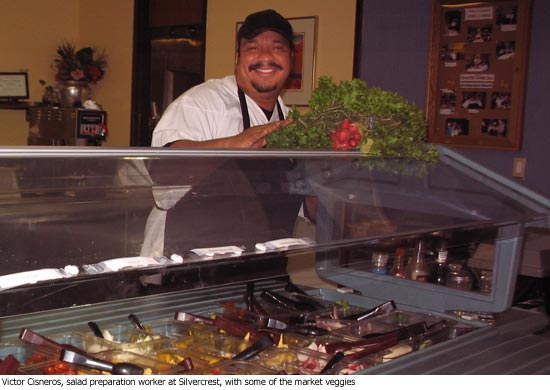Healthy Living
Does your kitchen make the grade?
September 9, 2010
 Friends say you cook like a top chef. Now find out whether your home kitchen earns an “A” for restaurant-level cleanliness standards, too.
Friends say you cook like a top chef. Now find out whether your home kitchen earns an “A” for restaurant-level cleanliness standards, too.
Using the A, B, C grading system similar to the one posted in restaurant windows, the county’s Department of Public Health lets you take an online “Home Kitchen Self-Inspection” and then scores the test to show where your kitchen’s standards are high—or not.
After submitting the test, you’ll get a letter and number grade, along with suggestions on how to correct any “violations.”
The test is intended to increase your understanding of day to day food safety issues, especially areas you may have long overlooked.
The 44 mostly yes-or-no questions range from super-basic (“My refrigerator is working properly”) to the tougher (“I wash and sanitize my sponge daily and replace it routinely when soiled.”) The test questions aren’t exactly the ones food inspectors use to grade restaurants, but they are adapted from the same state Health and Safety Code regulations.
Before the quiz, you’re required to answer several personal questions, such as your city, age range and gender. You’re also asked a series of questions that the department’s director, Dr. Jonathan Fielding, says are designed to “help us enhance our domestic food safety outreach efforts.”
If you score 90 percent or better, the public health department will mail you an “A” grade inspection card to display proudly in your kitchen.
And, in case you don’t feel like cooking tonight, here’s the department’s grading list for retail establishments.
Posted 9-8-10
Sleeping with the (bed bug) enemy
August 4, 2010
 What used to be a throwaway line before bedtime—sleep tight, don’t let the bed bugs bite—has new significance in Los Angeles County these days. Bed bugs have long been in residence here, but now their presence has reached epidemic proportions, prompting experts to scratch their heads—and others to scratch all over.
What used to be a throwaway line before bedtime—sleep tight, don’t let the bed bugs bite—has new significance in Los Angeles County these days. Bed bugs have long been in residence here, but now their presence has reached epidemic proportions, prompting experts to scratch their heads—and others to scratch all over.
What’s more, public health officials say that across the country there’s evidence that the insects are moving out of the bedroom and into less expected venues, like buses and movie theaters. With all the talk about bed bugs these days—they even figured in a plot line on an episode of “30 Rock”—it’s easy to become alarmed at the prospect of a seemingly unstoppable and ubiquitous pest.
But these dreaded insects are hardly invisible. They can be seen with the naked eye, so knowing the enemy is fairly simple. The Internet is full of bed bug photos; there’s even a site called Pictures of Bed Bugs. And there are a number of basic, common-sense steps you can take to protect yourself. (More about those shortly.)
Still, figuring out the reasons behind bed bugs’ L.A. population explosion is a little more complicated.
“There are a number of theories out there, but no one’s ever going to know for certain why bed bugs suddenly became such a big problem,” says Gail VanGordon, chief environmental health specialist for the Los Angeles County Public Health Department’s Vector Management Program. “When I started at the health department 25 years ago as an entomologist, I saw maybe one or two bed bug cases a year. And for some reason in the early ‘90s the number started creeping up to the point where they are really an epidemic now. One of the theories is an increase linked to global travel.”
Other possible factors are an increased bed bug resistance to pesticides or—at the other end of the spectrum—less pesticide use by environmentally conscious consumers. “We’ve learned to distrust pesticides,” says Alec Gerry, an entomologist at UC-Riverside. “In the old days, we trusted the heck out of them and used them all over the place and we didn’t worry about the consequences to the environment or to ourselves.”
The good news is that humans are still smarter than bed bugs; the bad news is that bed bugs are very good at what they do. With no need for thumbs to catch a ride, bed bugs expertly hitchhike from place to place by crawling into clothing, backpacks, suitcases or any other item that rests on the floor in close proximity to humans.
Sometimes people panic and misinterpret a simple insect bite as evidence of bed bugs.
But knowledge is power. By learning the facts, your chances of hosting an infestation are greatly reduced. Here are some tips:
Be careful what you bring into the house. “If they are going to buy furniture or trade furniture, don’t bring anything in where bed bugs can hide. They should check it very closely,” VanGordon says. “We don’t recommend buying used furniture at this time because so much of it is infested.”
Cleanliness is your best weapon. “Sanitation is topmost. People would think it’s pesticides, but it’s not. It’s just very good housekeeping,” VanGordon says. Bed bugs are easily vacuumed up with a strong hand tool and consistently washing bedding is an effective strategy for prevention. Still, people in apartment buildings should practice extra caution when using shared laundry rooms. VanGordon recommends buying washable laundry bags to reduce the possibility of bed bugs crawling into hampers or baskets placed on the floor.
Don’t let your guard down when you’re on vacation. Hotel and motel rooms are bed bug hot spots. Travelers should take extra precautions no matter where they are staying. VanGordon has a routine she uses when staying at a hotel.
“We put our luggage in the middle of the room and lift the head board off of the wall and look behind the head board and look underneath, looking for the signs of bed bugs,” said VanGordon. “Then, even when we feel comfortable, a lot of times we won’t even take our clothing out and put it in the furniture provided in the room. A lot of us just pull it out of the suitcase and we keep it on the rack and check very carefully for signs of bed bugs.”
Keep a close watch on your bed—or wherever you fall asleep. Bed bugs earned their name for a reason. With nocturnal habits, they lurk close to a predictable nighttime blood supply, most often a bed, but sometimes a sofa or chair if that’s where you doze off. And then they start feasting.
“Eighty-five percent of populations are located within 15 feet of the center of the bed,” VanGordon says. So if you think you have an infestation, start there. Systematically search all surfaces on and near the bed, and vacuum or wipe up the bed bugs and clean off any remains they’ve left behind. And consider removing as much clutter as possible from your bedroom because clutter is just one more place for bed bugs to hide.
“Prevention is always better than addressing an established bed bug infestation. Know the signs and address it immediately,” VanGordon says.
More public health tips—including guidance on what to do if preventive measures fail and the bed bugs do move in—can be found here.
Posted 8/4/10
Death by ZIP code
July 27, 2010
Nestled against the mountains, at the foot of Angeles Crest Highway, is La Canada Flintridge, one of the region’s wealthiest enclaves, a place where the residents not only prosper but live long.
According to a provocative new report by L.A. County’s Department of Public Health, La Canada Flintridge residents have an estimated life expectancy of 87.8 years—longer than anywhere else in the county.
Then there’s Westmont, a community in the challenging flatlands of South Los Angeles, where incomes are low, crime is high and drop out rates are through the roof. There, public health officials estimate that life expectancy is the worst in the county—72.4 years. Put another way, Westmont residents might live an average of 15 fewer years than the residents of La Canada Flintridge.
This stunning disparity is the central point of the Public Health Department’s most recent community-by-community exploration of how socio-economic factors are influencing our health and mortality.
“It’s a tall mountain to climb,” Public Health Director Dr. Jonathan Fielding said of the problems eroding life expectancy in dozens of communities. “But you climb a mountain one step at a time.”
Last month, the department released a detailed report on smoking rates throughout the county.
Its latest report—“Life Expectancy in Los Angeles County: How long do we live and why?”—ranks life expectancy in more than 100 local cities and communities with populations larger than 15,000. To bring deeper meaning to those numbers, the report also ranks these same places through an “economic hardship index,” a measure that includes such factors as poverty, unemployment, education and housing.
In an introduction to the report, Fielding called the results “sobering,” saying that they show “reduced life expectancy is strongly related to community-level economic conditions.”
“Poorer neighborhoods,” the report explains, “may have fewer large grocery stores, resulting in less access to fresh, nutritious and affordable fruits and vegetables, and may have fewer outdoor recreation areas and safe places where children and families can play.”
Fielding and his staff caution that the correlations between life expectancy and economic hardships are based on statistical assumptions, the availability of records and the size of the population pools. For example, the community of Lennox ranks among the highest in life expectancy but, conversely, ranks among the worst in social problems.
Beyond neighborhood rankings, the study also examines the widely varying life expectancy rates between races and genders, including this extreme example: an Asian/Pacific Islander female is expected to live 18 years longer than a black male (86.9 vs. 69.4).
Despite the troubling disparities between communities and individuals, Fielding noted that, in the bigger picture, the news is good because life expectancy has risen nearly five years since 1991. “That’s amazing,” he said. “We’ve made enormous progress.” The countywide average is now 80.3 years, according to the report
At its heart, the life expectancy study is a call to action by the Public Health Department. It recommends a number of strategies to begin closing the longevity gap, ranging from providing more recreational opportunities, to fostering more social connections, to increasing public safety and limiting access to alcohol and drugs.
Here’s a list of the Top 10 communities with the longest and shortest life expectancy. To see how your community ranks, click here.
Posted 7/27/10
L.A.’s great smoking divide
June 22, 2010
 Folks in San Marino, Malibu and Calabasas can breathe easy.
Folks in San Marino, Malibu and Calabasas can breathe easy.
But for those of you in Quartz Hill, Lancaster and West Hollywood—don’t throw away the nicotine patches just yet.
A new public health report on smoking in L.A. County is out, and it’s naming names. The report is the first of its kind to break out the county’s adult smoking rates by city and community. The disparities are striking.
San Marino boasts the county’s lowest rate of adult smoking, 5.3%, closely followed by Malibu at 5.8%. Next are La Canada-Flintridge (6.4%) and Calabasas (7.3%.)
“Our people in the community care about health. We care about and talk about healthy lifestyles,” says San Marino Mayor Dennis Kneier. His constituents, he says, “are very educated people who are aware of and conscious of the health risks of smoking.”
At the other end of the spectrum is Quartz Hill in northeast Los Angeles County, where 21.9% of the adult population smokes. Lancaster is next, at 21.7%.
“Coming from a long line of smokers, let me tell you: people up here smoke too much,” says Cindy Brody, a library assistant in Quartz Hill. “I was born here, and it hasn’t changed much in over 50 years. Face it, we’re not Hollywood.”
In West Hollywood, which has the fourth highest incidence of adult smoking in the county (19.6%), a task force of business and community leaders was convened in December to explore a new ordinance that would ban outdoor smoking on restaurant patios, open common areas and service areas such as ATM lines. The measure is expected to be brought before the city council in the next few months. The city already prohibits indoor smoking in public places and workplaces.
The county report draws on 2007 smoking data and population information from the 2000 U.S. Census. Some cities and communities, such as Avalon, Bradbury and Hidden Hills, were too small to be included. In all of Los Angeles County, there are an estimated 1.06 million smokers—14.3% of the adult population. (To see how your community ranks, scroll down to Table 1 of the report.)
Dr. Jonathan E. Fielding, the county’s director of public health, says in a foreword to the report that Los Angeles has one of the lowest smoking rates of any big metropolitan area in the U.S. He credits that to factors such as cigarette tax policy, “aggressive anti-smoking media campaigns” and smoke-free indoor ordinances.
He also reports that smoking among high school-age teens in Los Angeles County has declined dramatically, from 26% in 1997 to 12% in 2005. But smoking rates among adult smokers have remained steady since 2002. In addition to the heavy toll this takes on individuals and families, smoking also contributes to the $4.3 billion that tobacco-related diseases cost the county each year—$2.3 billion of it spent directly on health care.
Fielding said in a statement released with the report that the information is meant to help local leaders develop effective anti-smoking policies. “Understanding where smoking rates are highest in the county allows policy makers to develop support for and establish programs and policies in the fight against tobacco use,” Fielding said. However, the report does not attempt to correlate such policies with smoking rates in individual communities.
L.A. County‘s smoking disparities aren’t just geographic. The report says men smoke more than women, and African Americans light up more than other ethnic and racial groups. People with college degrees and higher incomes tend to smoke less than others.
In Quartz Hill, Brody, 55, thinks her community’s smoking habit can be partly attributed to economics.
“It’s a poor community, nobody has any money and they have nothing to do up here,” she says. She notes that long commuting distances also contribute to high stress levels for many.
Never a heavy smoker, Brody gave up cigarettes some 30 years ago.
“Now if I could get my husband to quit,” she says, “I’d be happy.”
This is the first L.A. County Public Health report to break out smoking rates by city and community. Previously, the department created such reports on childhood obesity and premature deaths from heart attacks and strokes.
Posted 6/22/10
A big step for Valley walkers
May 7, 2010
The walking doc’s back. And in case you missed him the first time around the block, here are a couple of things he won’t be bringing with him: a pedometer and a drill master’s go-for-the-burn attitude.
In fact, Dr. Glenn A. Lopez, creator of the Walking in Community program now up and running in Sun Valley and Sylmar, thinks the “community” piece of the equation is just important as the exercise itself when it comes to building healthy habits that last.
Lopez is an assistant professor in UCLA’s Department of Family Medicine and president of OnSite Health Solutions, a mobile medical clinic serving uninsured and chronically ill patients. At a press conference Monday, officials from the Health Net Foundation are expected to announce a $200,000 grant to his company to expand his mobile medical care to, eventually, 18 San Fernando Valley locations. Providence Health & Services previously contributed to, and currently contracts with, Lopez as well.
Lopez’s community-based approach to medicine is at the heart of his free walking program. And to get that effort off on the right foot, Lopez started by simply listening.
Before the initial launch of Walking in Community in 2006, he interviewed 200 families to learn more about their interests and attitudes.
“We got some very surprising results,” he says. “Eighty-three percent were very interested in walking with their neighbors around the block if somebody else set it up. It was about getting to know your neighbors.”
For women, that ranked as the No. 2 reason for starting a walking regimen, right behind “health and losing weight.” For men, it was reason No. 1.
Throw in a little motivation in the form of a free yellow T-shirt for people who’ve walked six times, and you’ve got a runaway—make that walkaway—success.
Eventually, more than 3,000 people took part—40% of them children.
“We had whole families walking together,” Lopez says. “These walking groups became like a community…And we found that if people walked for two weeks, they had a 75% chance of still walking three months later.”
Funding for the original effort ran out in 2008, but now the program is back, underwritten with two $25,000 grants—one from the county, on a motion by Supervisor Zev Yaroslavsky, and the other from Los Angeles City Councilman Tony Cardenas.
Groups currently are walking three times a week at three San Fernando Valley sites: Sun Valley High School, Sun Valley Middle School and Sylmar High School.
“It’s great,” says Carmen Holguin, 42, who was among those promenading around Sun Valley Middle School on a recent evening. “You move, you feel good, the stress is less. Your weight is less, too.”
Family groups are out in force. One extended group includes a 5-year-old on a scooter, her mother, three aunts and her 69-year-old grandmother.
No one, it seems, is walking alone. “They know each other, and it’s safe here,” says one of the leaders, Alejandrina Lopez, who was there with her daughter, Stephanie, a 6th grader.
“A lot of [original participants] are coming back,” says Veronica Camacho, the program’s director. “They were begging us to come back.”
Lopez says the idea for the walking groups grew out of his earlier studies of programs to combat asthma, childhood obesity and diabetes—a disease that is prevalent but often untreated among many in his predominantly Latino clientele.
Lopez, who received his medical degree from Cornell and did his residency at Cook County Hospital in Chicago, also worked for 10 years in rural Guatemala, administering medical care to workers on coffee and banana plantations from the back of his pickup truck and eventually building a network of 94 work-site clinics. As poor as his patients there were, he says, they “had the most important thing”—a sense of connection.
Lopez, 53, who lives in Northridge with his wife and two children, says he thinks his communal exercise program can help combat social isolation that leads to depression, a common problem among those he serves here in Los Angeles.
“Isn’t it ironic and isn’t it fantastic,” Lopez says, “that our marginalized communities are showing a way to come together and support each other?”
He also believes that small steps can be incredibly powerful.
“If I had to rate what is the most important thing about the walking, it is to welcome people, to be congenial and tolerant. This is a way of breaking the isolation that people are living in.”
And as for fancy hi-tech equipment? You can leave that at home.
“I’m against the use of pedometers,” he says. “If you’re 150 pounds overweight, OK, you’ve got to do 10,000 steps. They do 100 and already their heart is racing. They give up.”
But remember the yellow shirt.
“People want their T-shirts,” Lopez says. “They want that sense of doing something bigger, being a part of something.”
Posted 5-07-10
Toss out those smokes, dust off that bike
March 25, 2010
Flush with a new $32 million public heath grant, Los Angeles County in the weeks ahead will begin attacking obesity and tobacco use by underwriting an array of nutrition and fitness strategies, including an innovative plan for bicycle and pedestrian paths near Metro rail stations.
In all, nearly 20 “Transit Oriented Districts” are being envisioned along the Metro Blue and Green lines in the City of Los Angeles and unincorporated county territories where obesity rates are particularly high among children and adults. The idea is not only to lay the groundwork for pedestrian and bike amenities around the stations but also to expand access into surrounding neighborhoods with populations of at least 550,000.
In a boon to the region’s increasingly organized cycling community, crucial funding also will be provided for environmental reviews of the county’s Bikeway Master Plan, a network of on- and off-road bikeways. The plan, currently being drafted, was facing a major hurdle because money for the assessments was expected to start drying up.
The county’s bike plan coordinator, Abu Yusuf, said he “was overjoyed” to learn of the infusion of money. “It wasn’t a sure thing,” said Yusuf, an avid cyclist. “We could have definitely been under the chopping block.”
These efforts, important as they are, represent just one facet of a sweeping strategy that the county’s Department of Public Health proposed late last year to U.S. Health and Human Services and the Centers for Disease Control and Prevention.
Facing intense competition from communities nationwide, Public Health was awarded $16 million for obesity, nutrition and physical activity projects, along with another $16 million for anti-tobacco efforts. The grant, provided under the American Recovery and Reinvestment Act (ARRA), was announced Friday.
“I personally know the challenges that come from quitting smoking and adopting better habits, such as exercising more and eating healthier,” said Supervisor Zev Yaroslavsky, who pushed public health officials to expand their proposal to include bicycle and pedestrian amenities as well as a social media campaign. “At a time when government so often has been forced to cut the budget, it’s nice to gain some new resources to create healthier, smoke-free environments and reduce chronic diseases such as diabetes.”
The grant monies, which were distributed nationwide, signify a turning point of sorts for the federal government, which traditionally has not invested huge sums at the local level for preventive health measures or for planning, policy support and logistical direction.
The largest chunk of the grant, for example, will finance six three-member “mobilization” teams that will be dispatched to work with community groups, local officials and others to support passage of second-hand smoke rules in at least 20 cities in L.A. County.
The county also will team up on several fronts with the Los Angeles Unified School District and the Los Angeles County Office of Education on issues ranging from physical education to the creation of more stringent nutritional standards for school meals.
Said Dr. Paul Simon, director of the county’s Public Health Chronic Disease and Injury Prevention: “We want to build healthier lives, from the ground up.”
To read additional details of the Public Health Department’s pitch to the federal government, as reported to the Board of Supervisors last November, click here.
In the fitness zone at El Cariso Park
February 25, 2010
This week, the County’s popular El Cariso Park in Sylmar will have something new to offer its visitors: a new Fitness Zone, an outdoor gym facility made possible through a joint program with the Trust for Public Land, a private non-profit conservation agency that offers seed money and partners with public agencies to promote healthy exercise options in public parks. A total of 21 Fitness Zones have been installed in County parks to date. Fitness Zones help park visitors get and stay fit with easy to use cardio, strength training, and flexibility equipment.
The dedication is set for Thursday, March 4 at 10 a.m.
Posted 2/25/10
Turning quarantined lemons into lemonade for Santa Monica seniors
January 11, 2010
One person’s quarantine is another’s tasty green feast. Or at least a nice contribution to the daily salad bar.
That’s what the people from the Salvation Army’s Silvercrest senior residence in Santa Monica started receiving from grower/vendors at the Santa Monica Farmer’s Market.
The market is one of the country’s premier venues of its kind and attracts top chefs from throughout the area. But since October 29, the market, along with 16 others on the Westside, has been under quarantine due to the discovery of mated female Mediterranean fruit flies in a local backyard. The quarantine rules mean that unsold produce on the Medfly host list can’t return home with the farmers after the market day is finished, if it has been on display. Which brings us to the market’s arrangement to help bring the garden-fresh bounty to local organizations such as Silvercrest.
You might say it’s making lemonade out of lemons—but since this is the Santa Monica Farmer’s Market, better make that pomegranate-infused lemonade with a sprig of fresh rosemary.
Laura Avery, who supervises all of Santa Monica’s farmers markets and manages the Wednesday market, said farmers are being judicious in how much produce they display for sale, given the restrictions. Produce left on the tables at the end of the market day is being offered to several community organizations in addition to Silvercrest, including a soup kitchen and Step Up on Second, which assists people with serious mental health issues.
As for the farmers, Avery said, “they’re glad to know it’s going to be used.”
“We’re excited about this relationship,” said Emily Seiler, administrator of the Silvercrest Residence, which offers apartment living on Fifth Street to 130 low- and moderate-income seniors. “Every Wednesday, at 1:15ish, we’re going to be arriving there with pickup trucks and boxes, and visiting each booth.”
The locally grown fruits and vegetables are a welcome addition to the lunches and dinners served to Silvercrest residents each weekday. “Certainly it’s going to reduce our produce cost,” Seiler said, adding that she was pleasantly surprised by this Wednesday’s first day haul.
“We got a box of oranges, a bag of lemons, some of those grape tomatoes, a half box of pomegranates, 5 or 6 groups of radishes, a box of lettuce of various types, 10-12-15 sprigs of rosemary,” Seiler said. “Every one of our meals has a full salad bar.”
Finding a use for the oranges is easy. Residents can take one back to their apartments for breakfast or a snack if they don’t eat it at lunch. And the lemons are sliced daily for iced tea. As for the more exotic ingredients, well, that promises to be a welcome challenge for the center’s cook.
“What she’ll do with the pomegranates,” Seiler said, “I’m actually not sure.”
Wild females (Medfly variety) crash party
November 23, 2009
 Ah, autumn at the Santa Monica Farmers Market: Heaps of glistening Meyer lemons, crisp Pink Lady apples, fragrant tangerines and guavas, deep orange persimmons…and acres of tulle netting and PVC pipe?
Ah, autumn at the Santa Monica Farmers Market: Heaps of glistening Meyer lemons, crisp Pink Lady apples, fragrant tangerines and guavas, deep orange persimmons…and acres of tulle netting and PVC pipe?
The inedible items on that list are courtesy of some uninvited guests—three wild female Mediterranean fruit flies, two of them sexually mature and “mated.” The flies crashed the Thanksgiving party early at Westside farmers markets, triggering a quarantine that will affect Santa Monica’s four markets and those in 11 other areas for months. In all, 17 certified farmers markets are affected.
That means that farmer-vendors at venues including the Wednesday Santa Monica market—widely regarded as one of the nation’s premier markets, and a must-shop-stop for L.A.’s top chefs—must protect all host fruit while it is on display in the quarantine area. And while they can bring in crops from outside the quarantine area, they can’t bring home unsold fruits and vegetables. Those must be either donated or dumped.
“Sales are going to go down,” says Dolores Cabral of Cabral Farms in Ontario, who sells at Santa Monica’s Saturday market. “People are going to ask questions. I’ve been through those quarantines for many years. It’s a big hassle with the nets.”
 The timing is terrible—this week’s pre-Thanksgiving Wednesday market in Santa Monica is the biggest of the year—but veteran market folks say it’s nothing they can’t handle.
The timing is terrible—this week’s pre-Thanksgiving Wednesday market in Santa Monica is the biggest of the year—but veteran market folks say it’s nothing they can’t handle.
“Fortunately, right now, it’s a fairly small deal,” says Laura Avery, supervisor of the Santa Monica Farmers Markets. “We’ve all been through this. We all know what to do.”
Phil McGrath of McGrath Family Farm in Camarillo, who will be selling produce ranging from heirloom tomatoes to haricot beans, agreed, but said this week’s “Thanksgiving Wednesday,” as it’s known at the market, will have an extra layer of complications on an already demanding day. “We double pick and triple pick items. We know it’s a big day… It’s a food frenzy.”
He said that he did not expect to take an economic hit, however. “We have such a loyal customer base,” McGrath said Tuesday. “The cash customers tomorrow are the truly the heart and soul of our business…There’s the Medfly hassle factor, but I know we’re going to sell out.”
The Medflies were caught Oct. 29 in a Santa Monica backyard in the one of the tens of thousands of traps that Los Angeles County has placed throughout the area. County Agricultural Commissioner Kurt E. Floren told the Board of Supervisors in a letter that day that the immediate area has been treated with hand-sprayed Spinosad bait, an organic product derived from soil bacteria. No aerial spraying is planned.
The quarantine, mapped here by the California Department of Food and Agriculture, affects a 65-square-mile radius from Santa Monica, taking in markets in Pacific Palisades, Venice, Mar Vista, Culver City, Westwood, Westwood Village, Brentwood, Century City, Playa Vista and West Los Angeles, as well as the La Cienega market.
The list of possible host fruits and vegetables that must be covered with tulle netting propped up with PVC piping includes eggplant, tomatoes, bell peppers, apples and avocados, as well as all citrus.
“The farmers are very good. The customers are very supportive. We’re not going to be (aerial) spraying,” Avery says. “The bottom line is nobody wants this bug to spread. The Medfly has never been established in California because of these procedures.”
USDA spokesman Larry Hawkins, who said other Medfly quarantines are currently in effect in San Diego County communities including Fallbrook and El Cajon, said the Santa Monica quarantine is expected to last six months, and possibly longer. He said vigilance is essential because the Medfly is such a destructive bug, known to infest 260 varieties of fruits, nuts and vegetables: “It’s the most significant fruit fly pest on the planet.”
Under quarantine rules, people who grow fruit at home are not allowed to transport it from their property. This state brochure contains other information about how consumers should handle Medfly issues.
County agriculture officials are particularly concerned about travelers bringing in fruit from places like Hawaii and Mexico.
“We don’t know where these Medflies came from this time,” department spokesman Ken Pellman says. “But we need the public’s help in not bringing in fruits, vegetables, and plant material from outside of the state or country unless it has been officially inspected, and not taking those things elsewhere when they are under quarantine.”

















 405 bridge work causes a stink
405 bridge work causes a stink
